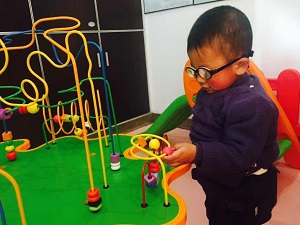Join a powerful, unprecedented alliance for better eye health for all.
Join IAPB-
Choose an alternate language here
Consistent monitoring and evaluating activity implementation is vital to ensure the quality of this project. We have been conducting it through multiple approaches.
Firstly, on-site observation & check has been applied to monitor school screening. For example, project hospitals were asked to screen 50-70 randomly chosen students who were already screened by teachers to compare screening results.
Recently, spot-check also included training and hospital support. The findings would inform which specific step needs to improve. For example, the teachers may need better training in recognizing common eye problems (e.g. squint or ptosis).
Results of spot-check showed that accuracy of vision screening done by teachers was as high as 79% to 87% on average but eye problems were missed to detect by many teachers. Feedback from teachers was lack of confidence in diagnosing eye diseases as it is too professional. The strategy taken for this issue was reinforcing hospital staff to train teachers to use ABC principles—“Appearance, behaviour and complaints”. Spot-check has been an effective approach to improve the quality of screening and alert hospitals for screening and training.

Supervising hospitals on how to utilize data collected helped in encouraging and motivating hospitals to do better. For example, to share school screening data which contains the screening information and referral details can help hospitals to understand what the problems exist, e.g. who needs to be referred and for what reasons (e.g. poor vision or eye problems), who have accepted eye service (e.g. glasses or surgery) or entry error (e.g. gender missing).
Secondly, we identified some key factors which hinder village screening through field visits. Knowledge and awareness of project staff in hospitals and key informants trained is one of the factors: some hospital staff and key informants were not interested in village screening even after training. They did not believe the project could help children living with visual or multiple disabilities in a poor family.

We also found out some of them were still confused about the multiple disabilities although it was explained the repeated trainings so we made a list of multiple disabilities which are commonly related to visual problem and also updated the training materials again based on issues identified through field visits. WeChat promotion slide was designed for facilitating the training and raising awareness.
Motivation is another barrier for village screening. Unlike school screening, cases identified and referred to local hospital can generate profit through optical service they provided while cases identified in village screening usually have serious problems which they cannot treat. Furthermore, they have to work much hard to convince key informants to screen and parents to take the child to the hospital.
The strategies taken included paying them travel allowance if they do screening in villages, encouraging them to screen children by integrating into other screenings and educate them that screening would bring them reputation among villagers.
We also collected reasons for slightly decreasing surgeries at SPEH which include: A new policy allows surgeons to practice in other hospitals (called multi-centre practice); Started from July 2016, many provincial doctors were deployed by government to lower level hospitals in the province for at least 6 months so in general the service volume decreased; many parents prefer to have surgery in Beijing because the distance from north Shanxi to Beijing is same as to SPEH while the service might be better; some doctors refer patients to other hospitals for referral fee.
Finally, some small researches conducted to inform actions for improving project implementation. It includes researches on accessing optical service, the facilitators and barriers to school screening, observing the use of “Five Big Ideas” and educational strategies being used throughout the preschool day, and ROP awareness among health professionals at county and prefectural levels.
These researches are either under analysis or nearly finished for data collection. Initial general findings from ROP awareness survey indicated ROP awareness and knowledge among participants were very poor. For example, most participants did not know what is ROP and have never heard about it or the screening guideline except small number of paediatricians or ophthalmologists in tertiary maternal and child hospitals or general hospitals heard of ROP and knew the screening criteria. The details of the survey will be available by the next reporting period.
The findings of these studies will be used to improve the research field. One to two more small researches may be carried out on village screening or service satisfaction or awareness improvement.
Image: Simon Way/Sightsavers